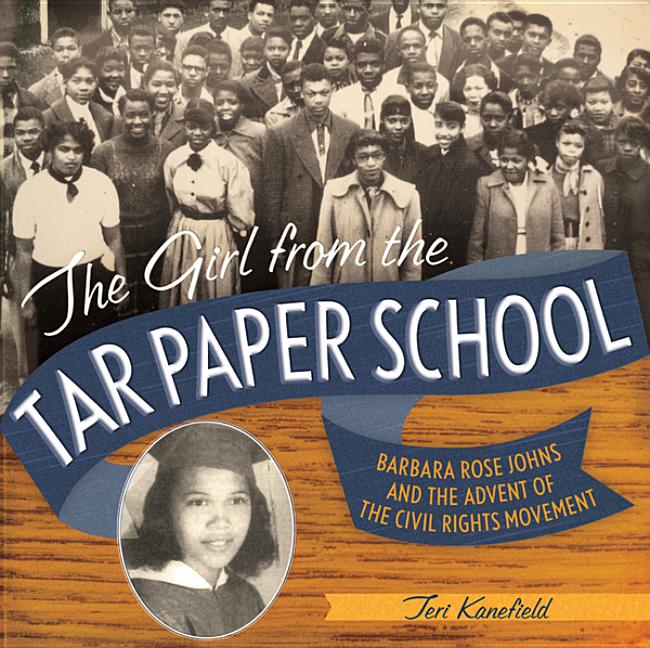
Book Resume
for The Girl from the Tar Paper School: Barbara Rose Johns and the Advent of the Civil Rights Movement by Teri Kanefield
Professional book information and credentials for The Girl from the Tar Paper School.
5 Professional Reviews (1 Starred)
5 Book Awards
Selected for 2 State/Province Lists
See full Book Resume
on TeachingBooks
- School Library Journal:
- Grades 6 and up
- Publisher's Weekly:
- Ages 10 - 14
- Kirkus:
- Ages 10 - 14
- Booklist:
- Grades 5 - 8
- TeachingBooks:*
- Grades 5-8
- Word Count:
- 10,153
- Lexile Level:
- 1100L
- ATOS Reading Level:
- 7.6
- Cultural Experience:
- African American
- Genre:
- Biography
- Nonfiction
- Year Published:
- 2014
22 Subject Headings
The following 22 subject headings were determined by the U.S. Library of Congress and the Book Industry Study Group (BISAC) to reveal themes from the content of this book (The Girl from the Tar Paper School).
- 20th century
- Juvenile Nonfiction | Biography & Autobiography | Historical
- Women civil rights workers--United States--Biography--Juvenile literature
- Civil rights workers--United States--Biography--Juvenile literature
- Virginia
- Juvenile Nonfiction | Biography & Autobiography | Women
- Segregation in education
- Women civil rights workers
- Juvenile Nonfiction | Biography & Autobiography | Social Activists
- Powell, Barbara Johns, 1935-1991--Juvenile literature
- Civil rights workers
- Women
- Civil rights movements
- Powell, Barbara Johns
- African Americans
- History
- Virginia--Race relations--History--20th century--Juvenile literature
- United States
- Segregation in education--Virginia--History--20th century--Juvenile literature
- Children's Books/Ages 9-12 Biography
- Race relations
- Civil rights movements--United States--History--20th century--Juvenile literature
5 Full Professional Reviews (1 Starred)
The following unabridged reviews are made available under license from their respective rights holders and publishers. Reviews may be used for educational purposes consistent with the fair use doctrine in your jurisdiction, and may not be reproduced or repurposed without permission from the rights holders.
Note: This section may include reviews for related titles (e.g., same author, series, or related edition).
From Horn Book
July 1, 2014
A heartfelt tribute to Barbara Rose Johns, a lesser-known heroine of the early civil rights movement. In 1951 Virginia, black Robert R. Moton High School and white Farmville High were separate but definitely not equal, and quiet Barbara and her classmates decided to strike. Profuse details, some extraneous, threaten to overtake the inspiring story of bravery. Timeline. Bib., ind.
(Copyright 2014 by The Horn Book, Incorporated, Boston. All rights reserved.)
From School Library Journal
Starred review from March 1, 2014
Gr 6 Up-This is the story of a Farmville, Virginia high schooler, who, in 1953, led a student strike for a better-built school on par with the building for white students. Although she was known as a quiet, reserved student, Johns was so incensed about the terrible conditions in which she and her classmates were required to learn that she engineered the exit of the principal from her school, mocked up a call to assembly, and then led students out on strike. She contacted the NAACP, which counseled that students return to class. When they refused, the organization told Johns that it would support only movements for integration. Students then worked to get an agreement to request integration from their parents and the broader black community. Once the community aligned behind integration as the eventual goal and a lawsuit was filed, students returned to class. The suit filed on behalf of the Farmville students ended up in the Supreme Court, one of the four cases that comprised the historic Brown v. Board of Education ruling. Beautifully and clearly written, this story of a teen who refused to be deterred in her pursuit of educational equality is matched by period photos-many of them located only after significant effort, as the Johns's home was burned-and primary source quotations. A "Civil Rights Timeline," solid end notes and source notes, and a sound index round out this excellent look at the roots and the breadth of the Civil Rights Movement.-Ann Welton, Grant Elementary School, Tacoma, WA
Copyright 2014 School Library Journal, LLC Used with permission.
From Publisher's Weekly
October 21, 2013
Kanefield (Rivka's Way) reveals Barbara Johns as an unsung civil rights pioneer in this biography for middle-grade readers. As the architect of a student strike in the segregated American south of the 1950s, Johns drew attention to the substandard school conditions she and fellow African-American classmates endured, often in classrooms with tar papered walls. "When it rained, the roofs leaked.... Some students sat under umbrellas so the ink on their papers wouldn't run." In piecing together this account of the courageous, outspoken Johns and the strike at Virginia's Moton High School, the author mines several sources, including Johns' handwritten memoir and interviews Kanefield conducted with Johns's family and friends. Numerous archival and contemporary photos appear throughout, and sidebars cover segregation, the KKK, and other relevant topics. While Johns' innovative, nonviolent protest against racial inequity didn't play out as expected, it did end up a part of the Supreme Court case Brown v. Board of Education, helping bring an end to school segregation. This stirring tribute to Johns is an important addition to any student collection of civil rights books. Ages 10—14.
From Kirkus
October 15, 2013
Kanefield tells the story of Barbara Rose Johns, whose fight for equality in the schools of Farmville, Va., went all the way to the United States Supreme Court. In 1950, 15-year-old Barbara Johns was a junior at the all-black Robert R. Moton High School in rural Virginia, a crowded school using temporary classrooms that were little more than tar paper shacks, more like chicken coops than classrooms, with leaky roofs and potbellied stoves that provided little heat. Farmville High School, the white school, was a modern building with up-to-date facilities. Sick of the disparity, Barbara led a strike, demanding equal facilities in the schools of her town. Her actions drew the usual response from the white community: cross-burnings, white stores denying credit to black customers and criticism for their "ill-advised" actions. Although threats caused Barbara's parents to send her to live with family in Alabama, where she graduated from high school, the Moton students' case was eventually bundled with others, including Brown v. Board of Education. In an attractive volume full of archival photographs, informative sidebars and a clearly written text, Kanefield shares an important though little-known story of the movement. A one-page summary of "The Birth of the Civil Rights Movement" and a civil rights timeline connect Barbara's story to the larger struggle; sadly, the bibliography offers no mention of the many fine volumes available for young readers who will want to know more. An important glimpse into the early civil rights movement. (author's note, sources, index) (Nonfiction. 10-14)
COPYRIGHT(2013) Kirkus Reviews, ALL RIGHTS RESERVED.
From Booklist
October 1, 2013
Grades 5-8 Barbara Rose Johns is not a household name, but she is one of the most important players in the early days of the civil rights movement. In 1951, 16-year-old Johns organized a series of peaceful demonstrations to draw attention to the substandard education she and classmates were receiving in their segregated tar paper schools, one-room shanties with leaky roofs and no heat. Drawing on inspiration from a favorite teacher and with the support of her family, Johns planned and led a strike at the school that garnered both positive and negative attention from the press and from peers. The demands that Johns made, including equality in educational facilities, would soon after be argued before the United States Supreme Court in the seminal case of Brown v. Board of Education. Well-researched and drawing heavily on Johns' own writings, and interviews with people who knew her best, Kanefield's text manages to create a story that is genuine and should serve as an example to any young person battling an injustice.(Reprinted with permission of Booklist, copyright 2013, American Library Association.)
5 Book Awards & Distinctions
The Girl from the Tar Paper School was recognized by committees of professional librarians and educators for the following book awards and distinctions.
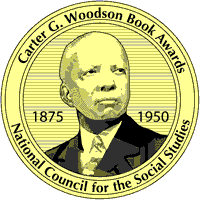 Carter G. Woodson Book Award, 1974-2024, Winner, 2015
Carter G. Woodson Book Award, 1974-2024, Winner, 2015
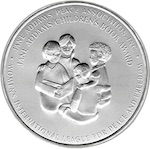 Jane Addams Children's Book Awards, 1953-2025, Winner, 2015
Jane Addams Children's Book Awards, 1953-2025, Winner, 2015
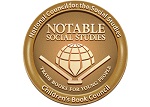 Notable Social Studies Trade Books for Young People, 2015-2024, History, Life, Culture in the Americas Selection, 2015
Notable Social Studies Trade Books for Young People, 2015-2024, History, Life, Culture in the Americas Selection, 2015
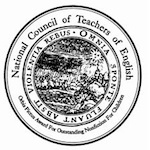 Orbis Pictus Award, 2000-2025, Commended, 2015
Orbis Pictus Award, 2000-2025, Commended, 2015
 Junior Library Guild Selections, 2012-2024, Nonfiction Selection, 2014
Junior Library Guild Selections, 2012-2024, Nonfiction Selection, 2014
2 Selections for State & Provincial Recommended Reading Lists
The Girl from the Tar Paper School was selected by educational and library professionals to be included on the following state/provincial reading lists.
United States Lists (2)
California
Iowa
- Iowa Elementary Battle of the Books, 2015, Grades K-5
Primary Source Statement on Creating The Girl from the Tar Paper School
Teri Kanefield on creating The Girl from the Tar Paper School:
This primary source recording with Teri Kanefield was created to provide readers insights directly from the book's creator into the backstory and making of this book.
Listen to this recording on TeachingBooks
Citation: Kanefield, Teri. "Meet-the-Author Recording | The Girl from the Tar Paper School." TeachingBooks, https://school.teachingbooks.net/bookResume/t/39935. Accessed 22 January, 2025.
Preview Digital Book
Explore The Girl from the Tar Paper School on Marketplace. Access requires OverDrive Marketplace login.
This Book Resume for The Girl from the Tar Paper School is compiled from TeachingBooks, a library of professional resources about children's and young adult books. This page may be shared for educational purposes and must include copyright information. Reviews are made available under license from their respective rights holders and publishers.
*Grade levels are determined by certified librarians utilizing editorial reviews and additional materials. Relevant age ranges vary depending on the learner, the setting, and the intended purpose of a book.
Retrieved from TeachingBooks on January 21, 2025. © 2001-2025 TeachingBooks.net, LLC. All rights reserved by rights holders.

